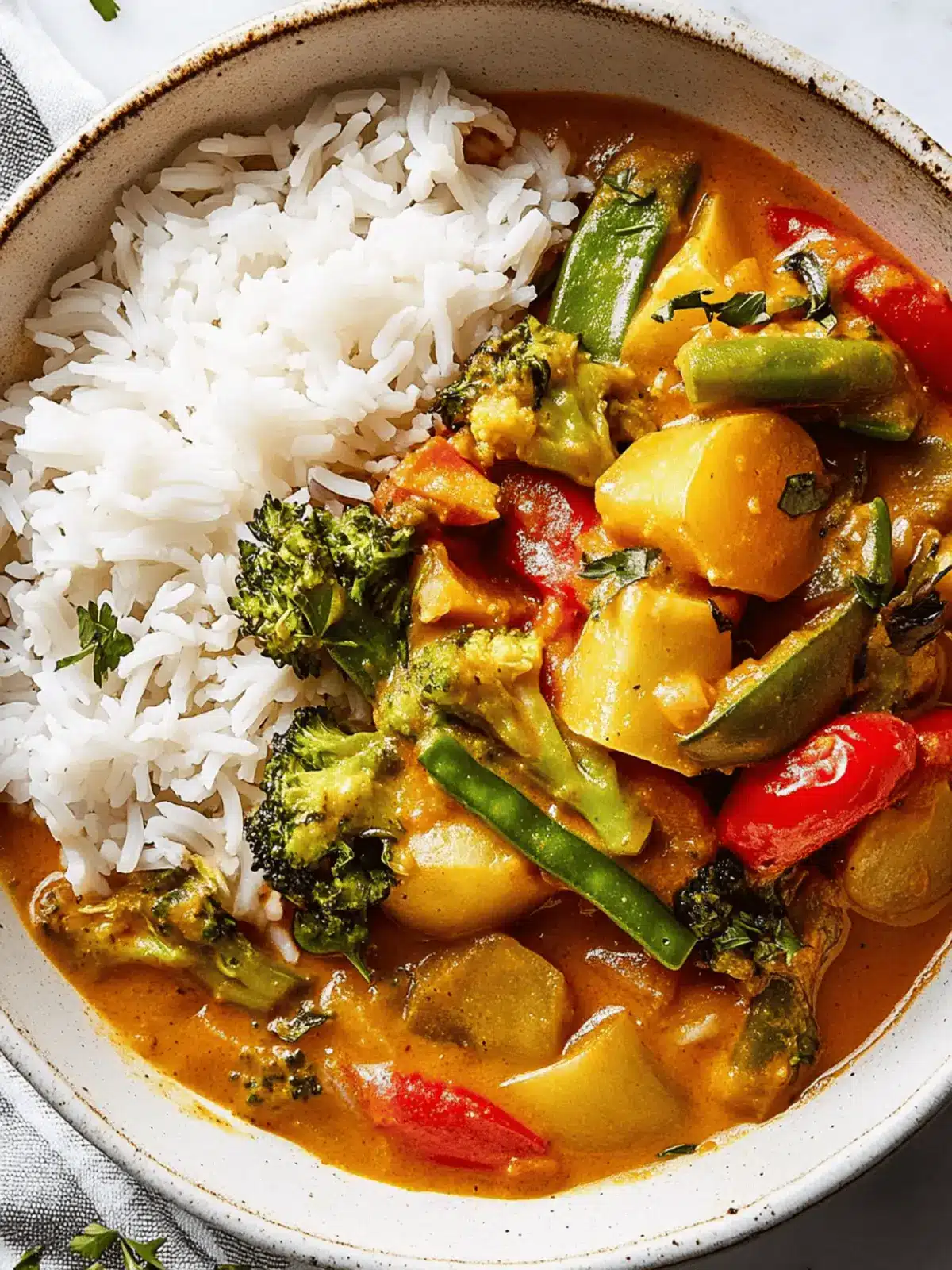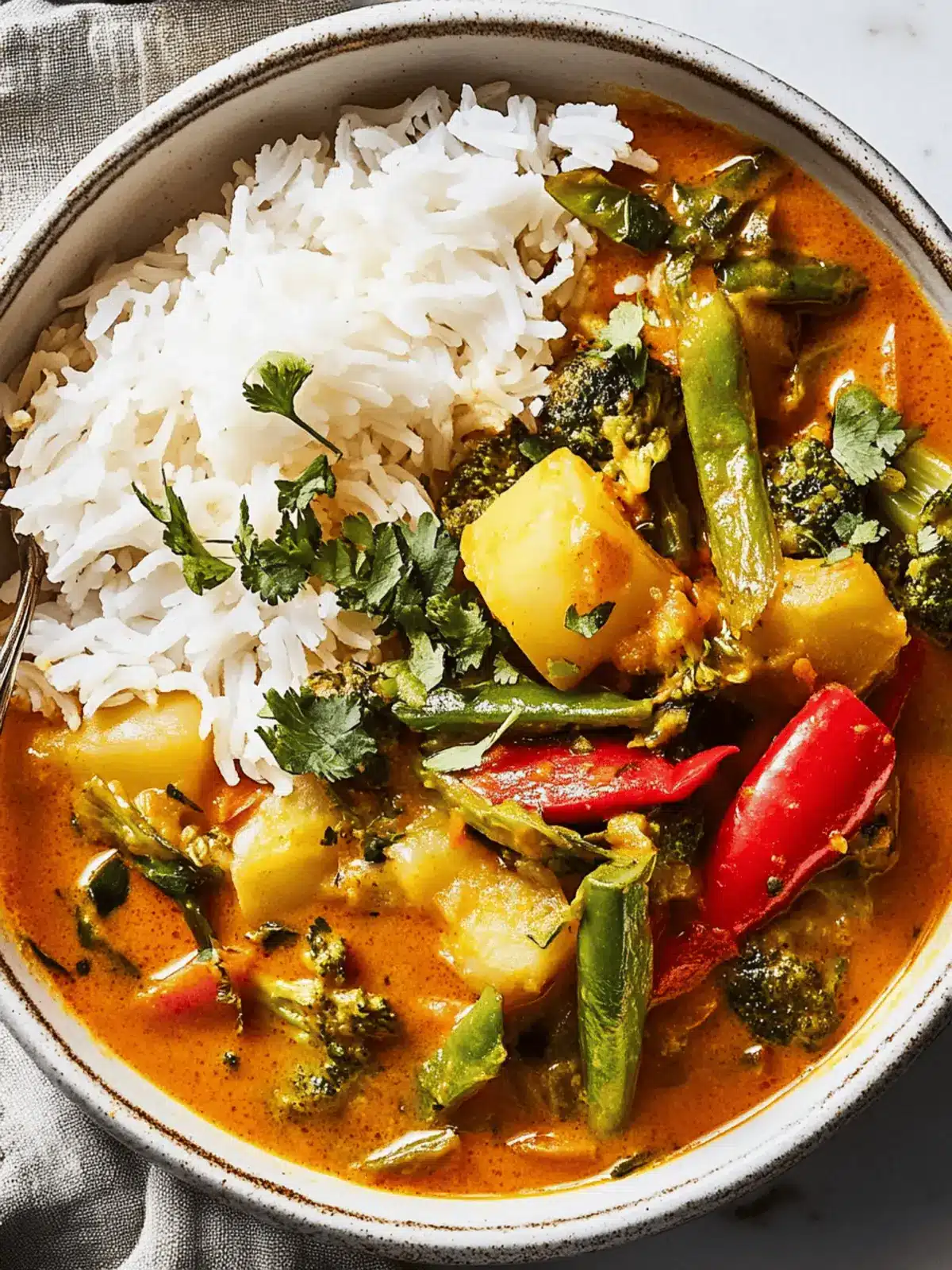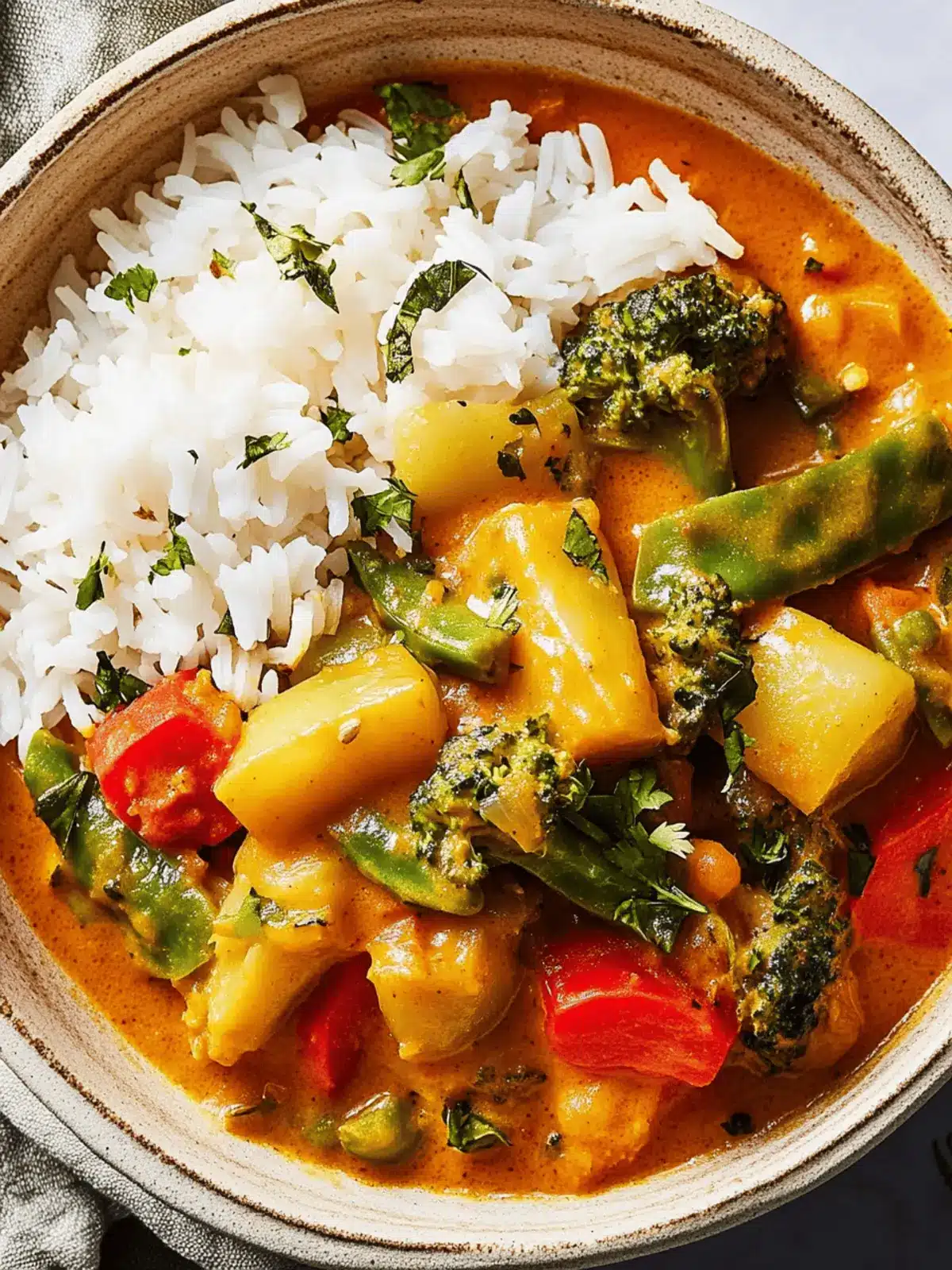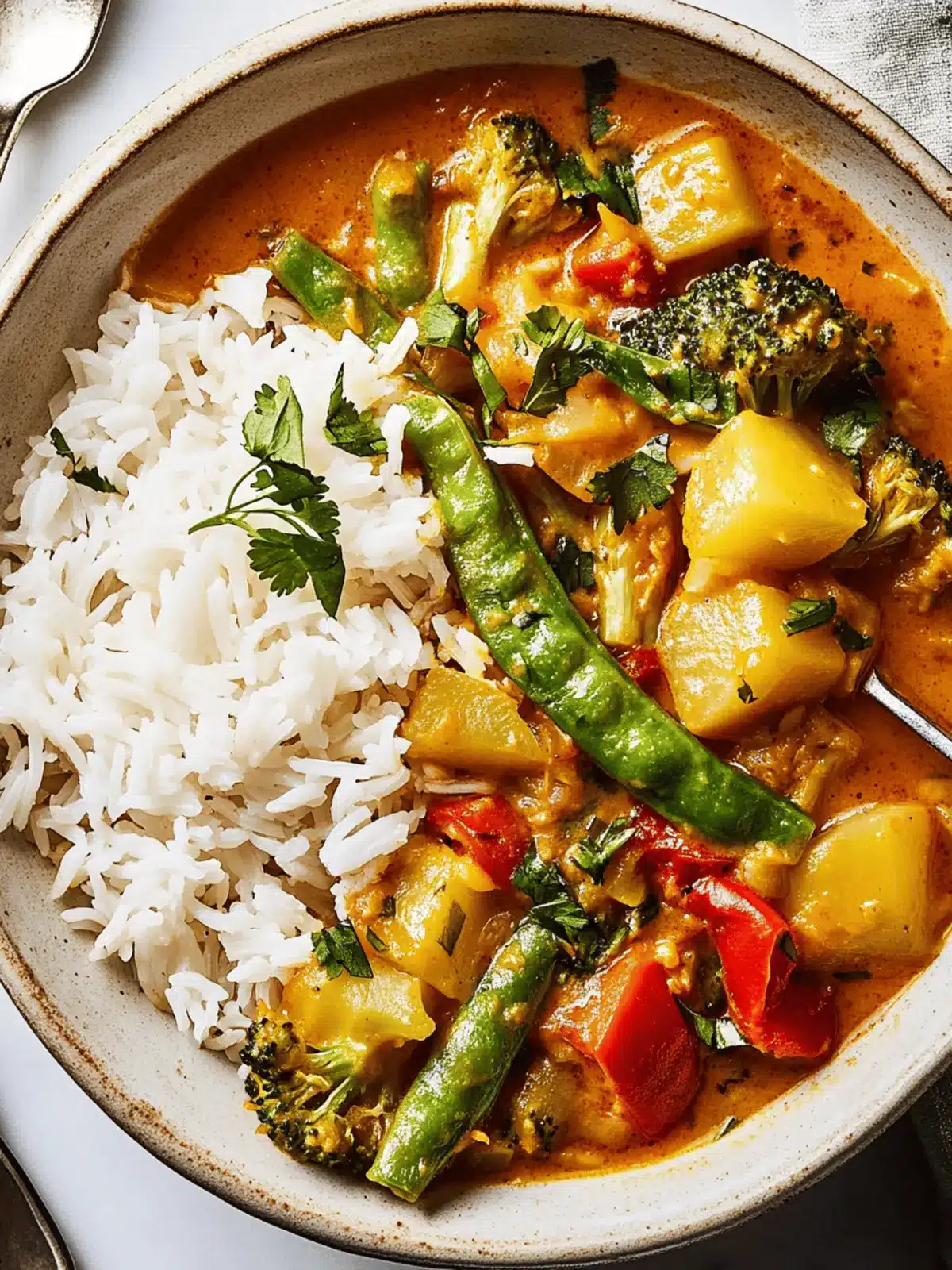When I first tried my hand at making curry, the blending of vibrant spices and creamy textures felt like painting a masterpiece right in my kitchen. This Creamy Thai Vegetable Curry is that beautiful creation, inviting and aromatic, ready to whisk you away to the bustling streets of Thailand with every bite. The rich coconut milk swirls with a medley of fresh vegetables, creating a bowl of comfort that warms both the body and soul.
Imagine diving into a luscious blend of carrots, potatoes, broccoli, and more, all harmoniously coming together in a dish that’s not just vegan and gluten-free but also incredibly easy to whip up after a busy day. In under 30 minutes, you can transform your weeknight dinners from mundane to magnificent! Let’s explore how to bring this colorful, satisfying curry to life—it’s time to reinvigorate your kitchen with a dish that delights the senses and makes fast food a distant memory.
Why will you love this Vegetable Curry?
Simplicity: This curry is a breeze to prepare, making it perfect for busy weeknights or meal prep.
Bold Flavors: Each bite bursts with a rich coconut flavor paired with vibrant spices that awaken your taste buds.
Nutrient-Packed: A medley of fresh vegetables ensures a healthy dish loaded with vitamins and minerals.
Versatile: Customize it with seasonal veggies or add protein like chickpeas or tofu for a heartier option.
Feel-Good Comfort: Indulge in the warm, satisfying feeling that comes from a wholesome bowl of curry, moving fast food further out of reach.
Crowd-Pleaser: Serve it at family dinners or gatherings, and watch as everyone dives in for seconds!
Vegetable Curry Ingredients
• Dive into deliciousness with this Vegetable Curry that’s as easy to prepare as it is to enjoy!
For the Base
- Neutral Oil – Used for sautéing; can be substituted with canola or coconut oil for a hint of flavor.
- Medium Yellow Onion – Adds sweetness and aroma; feel free to switch to shallots for a milder taste.
- Garlic (4 cloves, finely chopped) – Provides a robust flavor; using fresh garlic enhances the overall taste.
- Ginger (1-inch piece, finely chopped) – Delivers warmth and depth; fresh is always preferable to powdered.
For the Curry
- Thai Red Curry Paste (3-4 tbsp or 1 jar) – The flavor foundation; use less for a milder curry and consider green paste for a different twist.
- Coconut Milk (2 cans) – Brings creaminess to the dish; light coconut milk can be used if you’re watching calories.
- Low-Sodium Vegetable Broth (1 cup) – Enhances flavor without excess salt; homemade broth is a wonderful alternative.
- Granulated Sugar (2 tsp) – Balances out the flavors; for a vegan option, switch to maple syrup or agave.
For the Veggies
- Medium Carrot (1 cup, sliced) – Adds sweetness and texture; other root veggies like sweet potato can make a delightful substitute.
- Medium Yukon Gold Potato (1 cup, cut) – Contributes creaminess; waxy potatoes work beautifully in this dish.
- Broccoli (small head, florets) – Provides greens and crunch; asparagus or green peas are tasty alternatives.
- Medium Red Bell Pepper (1 cup, cut) – Adds sweetness and vibrant color; any bell pepper color will do!
- Green Beans (3 oz, halved) – Offers a crisp texture; try replacing them with snap peas or zucchini.
Optional Seasoning
- Reduced-Sodium Soy Sauce or Fish Sauce (3 tbsp, optional) – Enhances umami; switch to tamari for a gluten-free option or omit entirely.
For Serving
- Cooked Rice (preferably jasmine) – Perfect base for the curry; quinoa can also work if you’re looking for a grain alternative.
- Fresh Cilantro – Adds freshness to the dish; swap with basil if you’re not a fan of cilantro.
How to Make Vegetable Curry
-
Sauté Aromatics: Start by heating your neutral oil in a large pot over medium heat. Add the sliced onion, minced garlic, and chopped ginger, cooking for about 3 minutes until fragrant and the onion is translucent.
-
Incorporate Curry Paste: Stir in the Thai red curry paste and cook for an additional 2-3 minutes, allowing the spices to bloom and release their amazing aroma.
-
Add Liquids: Pour in the coconut milk and vegetable broth, then add the granulated sugar. Stir well and bring the mixture to a gentle boil.
-
Cook Root Vegetables: Add the sliced carrots and diced potatoes. Reduce the heat to low and let it simmer for about 15 minutes, or until the carrots and potatoes are tender.
-
Add Remaining Vegetables: Toss in the broccoli florets, bell pepper, and green beans. Cook for another 5 minutes until all the veggies are just tender but still vibrantly colored.
-
Seasoning: Give your curry a taste and adjust the seasoning as needed, adding soy sauce or fish sauce for that extra umami kick.
-
Garnish and Serve: Serve your warm vegetable curry over a bed of jasmine rice, and finish it off with a sprinkle of fresh cilantro for a burst of flavor.
Optional: Add a squeeze of lime juice for a zesty finish!
Exact quantities are listed in the recipe card below.
Make Ahead Options
These Creamy Thai Vegetable Curry preparations are perfect for busy home cooks! You can chop and refrigerate the vegetables—like carrots, potatoes, and bell peppers—up to 24 hours before cooking. Additionally, the curry base (aromatics, curry paste, coconut milk, and broth) can be prepared in advance and stored in an airtight container for** up to 3 days**. To maintain the quality, be sure to keep the veggies well-sealed to prevent browning. When you’re ready to enjoy, simply sauté your saved aromatics, add the liquids and fresh vegetables, and simmer until everything is cooked. This way, you can enjoy a delicious home-cooked meal in no time, with minimal effort!
What to Serve with Creamy Thai Vegetable Curry?
Elevate your dining experience with delightful pairings that complement the rich flavors of your creamy curry.
-
Jasmine Rice: A fragrant base that absorbs the creamy sauce beautifully, enhancing each bite of the curry.
-
Quinoa Salad: Adds a nutritious crunch and a nutty flavor, making for a delightful contrast to the smooth curry.
-
Crispy Spring Rolls: These provide a satisfying crunch and are perfect for dipping into the curry sauce—an irresistible combination.
-
Fresh Garden Salad: Light and refreshing, a simple salad with cucumbers and tomatoes balances the richness of the curry.
-
Coconut Chia Pudding: For dessert, this creamy, lightly sweetened treat echoes the coconut flavors in the curry and keeps it vegan.
-
Iced Green Tea: A cool drink with subtle notes that refreshes your palate while complementing the warmth of the curry.
Feel free to mix and match these options to create a meal that feels both comforting and exciting!
How to Store and Freeze Vegetable Curry
Fridge: Store your vegetable curry in an airtight container for up to 3 days, ensuring it retains its delightful flavors.
Freezer: Freeze portions in airtight containers or freezer bags for up to 3 months. When ready to enjoy, thaw overnight in the fridge before reheating.
Reheating: Gently reheat on the stove over low heat, adding a splash of vegetable broth or water to loosen the curry if it thickens.
Serving Freshness: Always taste your curry when reheating, and feel free to adjust seasoning or add fresh herbs for a burst of flavor.
Vegetable Curry Variations
Customize your curry experience and create a delightful dish all your own with these tempting twists!
- Seasonal Choices: Replace vegetables based on what’s in season—try eggplant, zucchini, or bell peppers for different flavors and colors.
- Protein Boost: Adding chickpeas, cubed tofu, or tempeh will provide extra heartiness, making it even more satisfying.
- Creamy Alternatives: Swap coconut milk with cashew cream for a uniquely creamy texture that still captures that comforting vibe.
- Heat It Up: Incorporate fresh minced chili peppers or a sprinkle of red pepper flakes to elevate the spice level to your liking.
- Herb Flavor: Add fresh basil or mint for a fragrant twist that brings a refreshing note to your curry, perfect for warm days.
- Nutty Crunch: Top with toasted peanuts or cashews to introduce an appealing crunch that pairs beautifully with the creamy sauce.
- Flavor Depth: Stir in a tablespoon of peanut butter or almond butter—believe me, it adds a delightful creaminess and unique taste!
- Curry Paste Variety: Experiment with green curry paste instead of red for an entirely different flavor profile that’s equally fantastic!
Expert Tips for Vegetable Curry
-
Toast the Paste: Before adding liquids, toast the Thai red curry paste for a few minutes to enhance its flavors and aromas.
-
Taste Before Salt: Remember to taste your curry before seasoning with salt; different curry pastes have varying levels of saltiness.
-
Add Vegetables in Stages: To ensure even cooking, add root vegetables earlier and quicker-cooking greens later in the process.
-
Customize Your Veggies: Feel free to use seasonal vegetables in your vegetable curry; swap in what you have on hand for added variety.
-
Store Mindfully: For food safety, refrigerate leftovers in an airtight container. Reheat gently to maintain the texture of your delicious curry.
Creamy Thai Vegetable Curry Recipe FAQs
What vegetables are best for this Vegetable Curry?
Absolutely! For this creamy Thai vegetable curry, I recommend using a vibrant mix of vegetables like carrots, potatoes, broccoli, and bell peppers. Feel free to customize based on what’s in season or what you have on hand. If you enjoy earthy flavors, consider adding in some eggplant or seasonal squashes.
How do I store leftover Vegetable Curry?
You can store your vegetable curry in an airtight container in the fridge for up to 3 days. To keep the flavors fresh, refrigerate it as soon as it cools. When reheating, gently warm it on the stove over low heat, stirring occasionally.
Can I freeze Vegetable Curry?
Yes, you can! To freeze your vegetable curry, let it cool completely before transferring it to airtight containers or freezer bags. You can freeze portions for up to 3 months. When you’re ready to enjoy it, just thaw overnight in the fridge and reheat gently on the stove, adding a splash of vegetable broth if needed to adjust the consistency.
What can I do if my curry is too spicy?
Very! If you find your curry has a bit too much kick, there are a couple of ways to tone it down. You can add a bit more coconut milk or even a touch of sugar to balance out the heat. Another option is to stir in some cooked rice or other starch to absorb some of the spice.
Is this Vegetable Curry suitable for a vegan diet?
Absolutely! This creamy Thai vegetable curry is entirely vegan. Just ensure the curry paste you choose doesn’t contain any fish products; many brands offer delicious vegan options. If you’re concerned about allergies, double-check ingredient labels for potential allergens that may be present.
What if I don’t have Thai red curry paste?
No worries! If you don’t have Thai red curry paste, you can create a flavorful substitute with a mix of spices. Combine 1 tablespoon of curry powder with a bit of chili powder, turmeric, and minced garlic. Stir this into your sautéed aromatics and adjust to your taste. Don’t forget to use coconut milk to achieve that creamy base!

Savory Vegetable Curry: Quick Comfort Food for All
Ingredients
Equipment
Method
- Start by heating your neutral oil in a large pot over medium heat. Add the sliced onion, minced garlic, and chopped ginger, cooking for about 3 minutes until fragrant and the onion is translucent.
- Stir in the Thai red curry paste and cook for an additional 2-3 minutes, allowing the spices to bloom and release their aroma.
- Pour in the coconut milk and vegetable broth, then add the granulated sugar. Stir well and bring to a gentle boil.
- Add the sliced carrots and diced potatoes. Reduce the heat to low and let it simmer for about 15 minutes, or until tender.
- Toss in the broccoli florets, bell pepper, and green beans. Cook for another 5 minutes until all the veggies are tender but still vibrant.
- Give your curry a taste and adjust seasoning as needed, adding soy sauce or fish sauce for an umami kick.
- Serve your warm vegetable curry over jasmine rice, and finish with fresh cilantro. Optionally, add a squeeze of lime juice.








